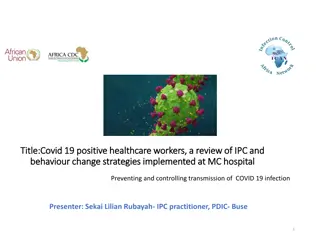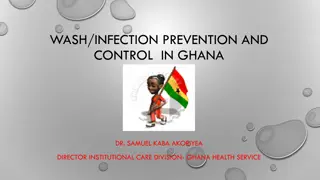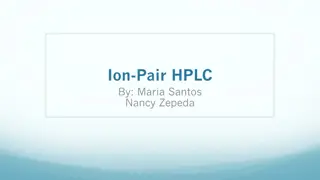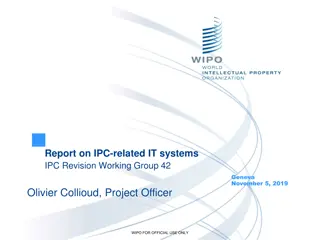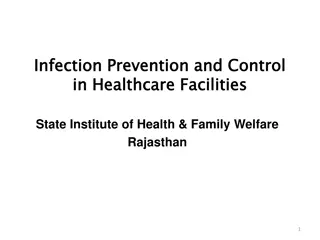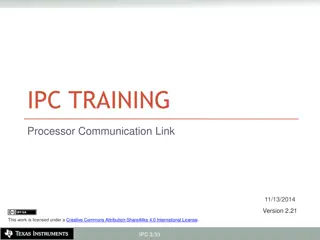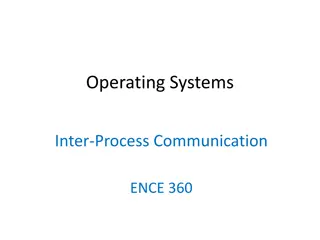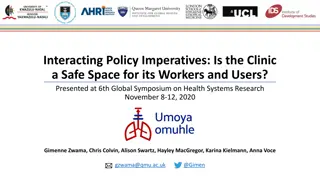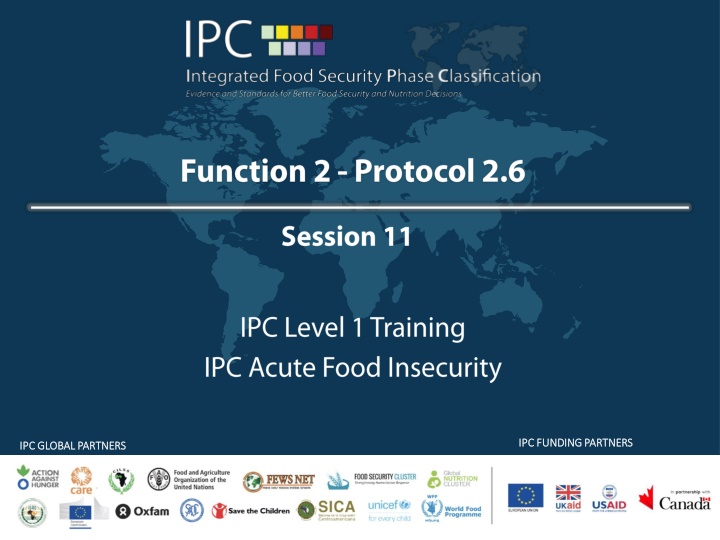
Protocol 2.6: Evidence-based Analysis and Classification Steps
Dive into Protocol 2.6, which promotes systematic evidence-based analysis, and explore the 12 steps for area classification. Understand how to document evidence systematically and develop future assumptions for humanitarian food assistance. Tags: IPC, Protocol 2.6, Evidence-based Analysis, Area Classification, Humanitarian Assistance.
Download Presentation

Please find below an Image/Link to download the presentation.
The content on the website is provided AS IS for your information and personal use only. It may not be sold, licensed, or shared on other websites without obtaining consent from the author. If you encounter any issues during the download, it is possible that the publisher has removed the file from their server.
You are allowed to download the files provided on this website for personal or commercial use, subject to the condition that they are used lawfully. All files are the property of their respective owners.
The content on the website is provided AS IS for your information and personal use only. It may not be sold, licensed, or shared on other websites without obtaining consent from the author.
E N D
Presentation Transcript
IPC FUNDING PARTNERS IPC FUNDING PARTNERS IPC GLOBAL PARTNERS IPC GLOBAL PARTNERS
Protocol 2.6: Systematically document evidence and analysis, and provide them upon request What is the objective of Protocol 2.6? To promote a systematic, transparent and consistent evidence-based analysis How does Protocol 2.6 work? It takes the analyst through the IPC Food Security Analytical Framework, calling for evidence and critical analysis as linked to the IPC Reference Table. The use of the Analysis Worksheet in the Information Support System (ISS) is a major advantage to IPC analysis and is highly recommended. Parts of the worksheets should be filled before the analysis workshop so that analysts can focus on critical review of evidence rather than on inserting evidence Every country needs to have focal point(s) to prepare the analysis worksheets/ISS, whom should have good knowledge of ISS
Protocol 2.6: The 12 Steps RELEVANT CLASSIFICATION STEPS STEP 1: Identify context and analysis parameters STEP 2: Populate the evidence repository STEP 3:Analyze evidence STEP 4: Determine area classification and population estimates STEP 5: Identify areas that received significant humanitarian food assistance STEP 6: Identify key drivers STEP 7: Identify key limiting factors STEP 8: Develop assumptions for future shocks and ongoing conditions STEP 9: Analyze evidence STEP 10: Determine area classification and population estimates STEP 11: Identify areas where significant amount of humanitarian food assistance has been planned and is likely to be funded and delivered STEP 12: Identify risk factors to monitor All Current Projection(s) Although Steps sequence has a logic, they are in fact often completed in a back and forth manner
Common to Current and Projected Classifications Step 1: Identify context and analysis parameters Relevance: Provide characteristics of the area to support contextualization of evidence and livelihood-based analysis - Unit of Analysis: Provides the focus of the classification defined by data availability, seasonality, decision makers needs, homogeneity, practicability. - Geographical unit - Time period validity (current and projected) - Important information for evidence contextualization and livelihood based analysis: - Description of the area and groups living in the area (including population estimates and seasonal patterns) - Chronic food insecurity level - Recurrence of crises 4 To be completed by the Technical Working Group before the analysis workshop
Common to Current and Projected Classifications Identify most important information to be included in Step 1 Exercise 11.1 In groups of 3-5 people: - Review the text about Step 1 in IPC Manual Part 2 A - Refer to the Workbook exercise 11.1. and select four statements that in your opinion should be included in Step 1 to support contextualization and livelihood -based analysis Be ready to share in plenary
Common to Current and Projected Classifications Step 2: Populate evidence repository Relevance: To help organize wide-ranging evidence from multiple sources for ease of access and reference Approach Overview: - World Food Program Emergency Food Security Assessment. Household survey conducted in January and February 2018 (WFP-EFSA/Jan2018) - Reference: Basic information about the source of evidence and date of evidence collection (start and end). - Survey designed at provincial level (4) with 20 clusters per province. Data disaggregated to relatively similar group of districts respecting at least the sample requirements needed - Note on Methods: Basic note on methods to support assessment of Reliability - Actual evidence: Such as text, numbers, tables, images etc. 6 To be completed by the Technical Working Group before the analysis workshop
Common to Current and Projected Classifications Exercise 11.2 Notes on methods Exercise 11.2 Task: With a partner/in a small group... 1. Refer to Step 2 in IPC Manual Part 2 A 2. Discuss with your partner/small group what information should be included in the note on methods, which helps analysts to identify the correct Reliability Score for the evidence 7
Current Classifications Step 3: Analyze evidence Relevance: To critically review relevant evidence following the IPC Analytical Framework and Reference Table. Approach Overview: Write Evidence Statements, including references to source and reliability Provide Key Conclusions
Step 3: Analyze evidence (cont.) Evidence Statements Some good practices Some good examples Relate values to the IPC Reference Table current value is over three times the rate found in the same season in 2016 (normal/reference year)... Compare to past conditions as data reflect the post-harvest period, it is worrying to see such high and greater than usual food gaps... Assess seasonality the unusual highly inadequate food consumption even after harvest was expected as households, especially the poorest and middle who are more reliant on sales of agricultural production, start to cut on dietary intake in anticipation to the hard year ahead. Contextualize given that area has a high reliance on small -scale agricultural production, a major source of food and income for over 70% of the population and accounts for over 80% of food and income for poor households, the sharp decrease of production (60% below last 5 years average production) means that the area is expected to be found in Crisis, or may deteriorate to Crisis in the near future. Infer Contributing Factors to Outcomes To be completed by the Technical Working Group before the analysis workshop as much as possible and reviewed by Analysis Team during workshop 9
Step 3: Analyze evidence (cont.) Conclusions Some good practices Some good examples For Contributing Factors Low food production was a major limiting factor Availability of food was not a limiting factor Access is still a minor factor Assess to what extent the element limits food security For Outcomes Food Consumption would point to Phase 3 Livelihood Change would point to Phase 2 Acute Malnutrition to Phase 3 Mortality to Phase 2 Provide Indicative Phase Classification For Contributing Factors & Outcomes Most vulnerable groups include those practicing agricultural labour, fishers, livestock owners, landless, marginalized groups, and those working in construction and as small business labourers, as many have lost their income due to the difficult situation in the governorates and surrounding districts. The lack of salary payment as well as the suspension of the safety net programme have affected the lives and livelihood of the communities as a whole. Stability and the expectation of a hard year after a previous hard year is a major factor Add a brief reasoning for the conclusion (as relevant/feasible) To be completed by the Analysis Team during workshop 10
Current Classifications Exercise 11.2 Prepare good evidence statements Exercise 11.3 Task: With a partner/in a small group... 1. Refer to Step 3 in IPC Manual Part 2 A 2. Formulate evidence statements based on pieces of evidence available. 3. Add e.g. hypothetical contextualization, historical trends and comparison to other data to make the examples better 4. Formulate a conclusion for food consumption element, based on available evidence and evidence statements 11
Current Classifications Step 4: Determine area classification and population estimates Relevance: To provide a critical review of supporting and contradictory evidence used to arrive at Phase classification and estimation of number and percentage of people in different Phases Approach Overview: Distribute the proportion of households in each Phase Conclude on area classification Provide conclusion for final classification Assign evidence level of classification 12
Current Classifications Step 4: Area classification & pop. estimates Distribute the proportion of households in each Phase Some good practices Some good examples Review all evidence in a cheat- sheet The whole body of evidence should be brought together for classification Take into account special considerations for convergence of evidence Although outcomes are more useful to estimate populations, inference from contributing factors and trend analysis are of special value. Analysis of specific household groups also supports population estimations Evidence does not always converge indicator, context and reliability should be considered (outliers should be reviewed) Both supporting and contradictory evidence should be assessed To be completed by the Analysis Team during workshop 13
Current Classifications Step 4: Area classification & pop. estimates Conclude on Area Classification Write a well articulated conclusion statement Use 20% Rule Summary key supporting and contradictory evidence into a short paragraph. Rule to be used on population estimations based on food consumption and livelihood change contributing factors and outcomes As much as possible, the conclusion should also mention which household groups are the most affected. Analysis Acute Malnutrition and Mortality Assess how acute malnutrition and mortality support/contradict classification To be completed by the Analysis Team during workshop 14
Current Classifications Step 4: Area classification & pop. estimates Food dimensions Key drivers Example of a well articulated conclusion statement Aruna has been classified in Phase 3 Crisis for the April July period. The key drivers of the situation are prolonged dry season and low purchasing power of the population due to high reliance on subsistence agriculture as the main livelihood. Due to the prolonged dry season estimated 40% of households have run out of their food stocks and are now using unsustainable livelihood coping mechanisms, such as sale of productive assets in order to afford to buy food at prices that are 50% higher than usual at this time of the year. 35% of households are using food coping (rCSI >19) and 48% have borderline or poor Food Consumption Score. The most affected are those with small plots who have already run of stocks, and casual labourers who are totally dependent on market for their food needs. Most affected household groups Outcomes To be completed by the Analysis Team during workshop 15
Current Classifications Step 5: Identify areas that received significant humanitarian food assistance Relevance: Identify areas that received a large amount of humanitarian food assistance in the period preceding the current analysis Approach Overview: Parameters included in Protocol 2.3-k to be followed Analysis to consider for example the size, duration, type, coverage of assistance and any issues that may prevent assistance from reaching or being utilised by beneficiaries, such as limited access or aid diversion Two-part process is suggested in IPC v3.0: analysts identify first whether assistance meets the criteria for flagging the area, and then review whether assistance has reached the intended beneficiaries. This process determines whether the mapping symbol for highlighting the presence of significant assistance is used Analysis has no impact on Phase classification or on population estimates 16
Current Classifications Step 5: Identify areas that received significant humanitarian food assistance (cont.) Two-part process PART 1: - At least 25 percent of the households met between 25 and 50 percent of their caloric needs through humanitarian food assistance; - At least 25 percent of the households met more than 50 percent of their caloric needs through humanitarian food assistance; Flag Areas that received significant Humanitarian Food Assistance as per two identified categories - Assess if any factors have prevented receipt and utilization of received assistance, such as: - Targeting - Sharing - Aid diversion - Thefts/corruption PART 2: Assess if any factors prevented delivery of HFA to intended beneficiaries To be completed by the Core TWG before and reviewed by the Analysis Team during workshop 17
Current Classifications Step 6: Identify key drivers Relevance: To enable decision-makers to identify main triggers of the current food insecurity situation so that action can be more strategically planned. Approach Overview: No authoritative guidance, only a brief set of considerations Basic understandings of what Shocks & Vulnerability factors are the major issues driving acute food insecurity Actual/Current = f Acute Food Insecurity f Hazard & Vulnerability In relation to specific hazards: Exposure: Experience of hazards Susceptibility: Ways the system is affected by hazards Resilience: Ability to withstand a hazard and return to previous conditions Damaging phenomenon that can be: Natural or human-induced Acute/sharp or chronic/on- going Seen in terms of: Probability Severity Magnitude Actual negative results/impacts of losses Analyzed in terms of: Livelihood Strategies: Food & income sources, usual coping & expenditures Livelihood Assets: 5 capitals Policies, Institutions, and Processes 18 To be completed by the Analysis Team during workshop
Current Classifications Exercise 11.6 Identification of key drivers Exercise 11.4 Task: With a partner/in a small group... 1. Refer to Step 6 in IPC Manual Part 2 A 2. Discuss what are typical key drivers of food insecurity in your country or in an area you are familiar with? You can also use the box on top left of the IPC Analytical Framework (Causal Factors) to guide your discussions 19
Current Classifications Step 7: Identify key limiting factors Relevance: To enable decision-makers to identify limiting dimensions of food security so that response can target appropriate areas of interventions (availability, access, utilization and stability) Approach Overview: Using evidence and analysis done in Step 3: Assess to what extent each dimension limits food security: Extreme limiting factor Major limiting factor Minor limiting factor Not a limiting factor Write brief statements as relevant and feasible Providing key reasons as to why this element limits [or not] food security Need to provide a written conclusion 20 To be completed by the Analysis Team during workshop
Current Classifications Exercise 11.7 Identification of key limiting factors Exercise 11.5 Task: With a partner/in a small group... 1. Refer to Step 7 in IPC Manual Part 2 A 2. Discuss what are typical key limiting factors to food insecurity in your country or in an area you are familiar with? You can also use the box on bottom left of the IPC Analytical Framework (Food Security Dimensions) to guide your discussions 21
Projected Classifications CURRENT CLASSIFICATION FINISHED START OF PROJECTIONS Step 8: Develop assumptions for future shocks and ongoing conditions Relevance: To provide analysts with expected outlook of the key factors to be considered when projecting the severity and magnitude of future acute food insecurity. Approach Overview: Describe key assumptions on impacts of shocks and ongoing conditions that are likely to affect food security in projected period considering: Seasonal/usual events and unusual shocks likely to happen Positive and negative shocks Events that have already happened or will likely happen The assumptions formulated in Step 8 will be used in Steps 9 and 10 as the basis of projection analysis Preferably to be completed before workshop and reviewed by the Analysis Team during the workshop 22
Projected Classifications CURRENT CLASSIFICATION FINISHED START OF PROJECTIONS Step 8: Develop assumptions for future shocks and ongoing conditions (cont.) The logical process of making assumptions How does food security normally behave in the projected period? How will shocks and anomalies [or will not] impact the normal trend of food security (positively and/or negatively)? Usually stocks run out by the last months of the projected period and households rely on purchases, wild foods, casual labour and hunting. Past analysis shows that even in normal years about 20% of HHs go into Phase 2 or more severe during this time. The low production (70% below 5 years avg.) means that HHs will run of stocks much earlier at least 4 months earlier. The prices are expected to increase up to 100% and casual labour opportunities are also expected to be lower than normal, as HHs are recovering from their losses. As planting starts in this period, forecasts for the next rainy season will also impact on casual labour opportunities. For now, it is assumed that next rainy season will be close to average and thus some casual labour opportunities will be available. Preferably to be completed before workshop and reviewed by the Analysis Team during the workshop 23
Projected Classifications Exercise 11.8 Identification of assumptions for projection period Exercise 11.6 Task: With a partner/in a small group... 1. Refer to Step 8 in IPC Manual Part 2 A 2. Discuss what example assumptions would you develop for the next season/projection period for an area you are familiar with. 24
Projected Classifications Step 9: Analyse evidence Relevance: To organize, evaluate and analyse evidence on forecasting of most likely future conditions of food security elements, taking into account their current levels, historical trends, past and most likely future impacts of shocks Approach Overview: Assess projected trends based on current conditions and context, historical trends and assumptions prepared in Step 8 Provide conclusions for the elements, including reference to evidence and critical reasoning. As much as possible conclude if elements are likely to improve, remain similar or deteriorate compared to current situation 25
Projected Classifications CURRENT CLASSIFICATION FINISHED START OF PROJECTIONS Step 9: Analyse evidence for projection (cont.) The logical process of preparing projections Is it possible to know by how much? Based on assumptions agreed, will this issue improve, remain the same or deteriorate? Using the agreed upon assumptions about crop production, food prices, labor opportunities, and wages, the size of the gap can be estimated for different wealth groups. In this case, the Outcome analysis suggests that during the peak of the lean season, the poor (35% of HHs) will face survival deficits equivalent to Crisis (Phase 3), while the middle wealth group (40% of HHs) will face livelihood protection deficits equivalent to Stressed (Phase 2). These findings point to a Phase 3 classification with at least 35% of population in Phase 3. Food consumption is likely to deteriorate substantially from current as HHs run out of stocks, prices increase and casual labour opportunities are limited. Preferably to be completed before workshop and reviewed by the Analysis Team during the workshop 26
Projected Classifications Exercise 11.9 Analyse evidence (projection analysis) Exercise 11.7 Task: With a partner/in a small group... 1. Refer to Step 9 in IPC Manual Part 2 A 2. Formulate evidence statements for projection based on pieces of evidence available 3. Formulate a conclusion for projection for food consumption element based on available evidence and evidence statements 27
Projected Classifications Step 10: Determine area classification and population estimates Relevance: To provide a critical review of supporting and contradictory evidence used to arrive at Phase classification and estimation of number and percentage of people in different Phases Approach Overview: Distribute the proportion of households in each Phase Conclude on area classification Provide conclusion for final classification Assign evidence level of classification 28
Projected Classifications Step 10: Area classification & pop. estimates Distribute the proportion of households in each Phase Good practice 1: Review expected trend of elements Based on analysis of current conditions, assumptions and historical trends Stocks to run out Less wild foods as dry season approaches Markets to have especially staples Own stocks of most HHs to run out, especially those of poor and middle WGs Income sources to be limited Prices to increase by 100% Deteriorate Significantly Food Availability Deteriorate Significantly Food Access Food UtilizationAccess to water to decrease only slightly because of high reliance on tap water Feeding and caring practices to remain similar Food Consumption likely more than 40-50% Households likely to start engaging in crisis strategies. The poor may resort to emergency strategies. Given that 10% of HHs were engaging in crisis and emergency strategies after the harvest (current), it is expected that at least 20- 40% engage in these during projection, especially accounting for the 30% of poor population Remain similar Food consumption to deteriorate significantly, by at least more than 20% but Deteriorate Significantly Livelihood Change Deteriorate Significantly To be completed by the Analysis Team during workshop 29
Projected Classifications Step 10: Area classification & pop. estimates Distribute a proportion of households in each Phase Good practice 2: Conclude how populations will likely move between and within Phases Assess current population estimates, analysis of projected elements and livelihood groups Phase 5: - No households are expected to go into Catastrophe due to social mitigating factors, wild foods and available livelihood assets. Phase 4: - Those who were in Phase 4 in current period are likely to continue to be in Phase 4 (5%) - Livelihood group analysis: Most of the poor (about 10% of total pop) with limited income and very low food production will likely be in Phase 4. In addition the poorest (5%) who lost all production and do not have alternative sources of income are likely to remain in Phase 4. As a result the total population in Phase 4 is expected to be 15% - Area -based analysis: Some of those who were in Phase 3 will move into Phase 4 and this deterioration may be between 20-40%. As current pop in Phase 3 is 25%, between 5 and 10% may move from Phase 3 to 4. - Overall conclusion: Phase 4 expected to increase from 5 to 10% Phase 3: - Phase 3 current will either move into Phase 4 or remain in Phase 3. If 10% move to Phase 4, 15% will remain. - Some of those who were in Phase 2 after harvest will continue to be in Phase 2 and some will move to Phase 3. Given that most HHs are expected to run out of stocks 4-6 months earlier than normal, the expected high price of food and the limited casual labour at least 30-50% of HHs currently in Phase 2 will move into Phase 3. And so on 30 To be completed by the Analysis Team during workshop
Projected Classifications Exercise 11.10 Potential challenges in preparing population estimates Exercise 11.8 Task: With a partner/in a small group/in plenary 1. Refer to Step 10 in IPC Manual Part 2 A 2. Discuss the projection analysis and identify potential challenges you might face when concluding projection analysis and estimating populations. Think also how you would deal with the challenges identified, and be ready to share your results in plenary 31
Projected Classifications Step 11: Identify areas where significant amount of humanitarian food assistance has been planned and is likely to be funded and delivered Relevance: Identify areas that would likely benefit from significant humanitarian food assistance in the projection period Approach Overview: - At least 25 percent of the households likely to meet between 25 and 50 percent of their caloric needs through humanitarian food assistance; - At least 25 percent of the households likely to meet more than 50 percent of their caloric needs through humanitarian food assistance; Same as current (analysis conducted in 2 parts) For projection assistance that is planned and Funded or likely to be funded and Analysis on whether aid is likely to reach intended beneficiaries or not e.g. due to conflict, aid diversion or logistical issues. Useful to look also at typical past performance with aid delivery. Likely to be delivered Two categories used as in Step 5: 32
Projected Classifications Step 12: Identify risk factors to monitor Relevance: To identify triggers for analysis updates and validity of projections. Approach Overview: Consider events that could increase or decrease food insecurity over the projection periods Examples include: consumer prices, second season rainfall, conflict etc. 33
Projected Classifications Exercise 11.12 Identify risk factors to monitor Exercise 11.9 Task: With a partner/in a small group... 1. Refer to Step 12 in IPC Manual Part 2 A 2. Identify typical risk factors to monitor for your country or area you are familiar with 34

